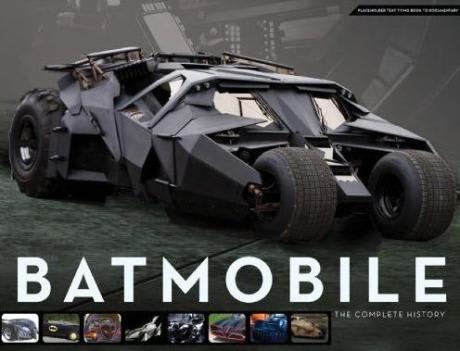As the title and cover art—a glossy, charcoal-coloured image of the Batmobile used in Christopher Nolan's trilogy of films—suggest, this exceedingly comprehensive and exquisitely photographed coffee table book outlines all things pertaining to Batman's chief method of transportation: the Batmobile.
Interviews, research, methodologies, anecdotes and extensive imagery—both from film sets and from the comic book—propel what is ostensibly a linear history of the machine from the unlikely red sedan driven in "The Case of the Chemical Syndicate," released in Detective Comics in 1939, through to the Tumbler-Batmobile that modern audiences would be most familiar with.
Interestingly, as the well-written and information-heavy book suggests, the evolution of the machine corresponds directly with the political climate of the time. Though early renditions of the Batman comic merely used a blue convertible with a bat symbol on the front throughout the '40s (something highlighted in the 1949 Spencer Gordon Bennett movie serial), the famed car eventually moved to a sports model in the '60s, leading up to the pop-inspired advent of the campy television series with Adam West and Burt Ward.
With colour TV coming into the picture and artists like Roy Lichtenstein and Andy Warhol modernizing the art scene, the televised version of the Batmobile became a nouveau work unto itself, with heightened stylistic flair and a more impractical aesthetic design that eventually bled into the comic universe. And with this continuing on through most of the decade until the '70s introduced a sleeker, muscle car exterior, not much change was made until the famed Tim Burton film version of Batman in 1989, when the 1950s pastiche was dropped for more of a sexually aggressive, phallic model.
Mark Cotta Vaz's book outlines the many opinions—both studio and creative—that went into developing these various designs, stepping back to provide context for the time, positing reasons why Burton's amped-up, pseudo-violent design was eventually replaced with the campier, flashy, throwback vehicle in Schumacher's Batman films that valued aestheticism over practicality.
When it finally gets to present day, pointing out that Christopher Nolan didn't even want the Batmobile present in his gritty, loose adaptation of The Last Halloween, there's such a rich context for the symbolic meaning of the vehicle and its relation to the series that it's hard to imagine the caped-crusader without it. And since the crisp photography throughout the book comes replete with full centrefolds, readers can compare and contrast the various vehicles throughout the era, assessing their own preferences, while learning a little something about American cultural history.
There are even detailed specs and blueprints, in case anyone was considering making a Batmobile of their own—something Bruce Wayne managed to do on the periphery of society without any real help prior to Nolan's somewhat plausible explanation.
(Insight Editions)Interviews, research, methodologies, anecdotes and extensive imagery—both from film sets and from the comic book—propel what is ostensibly a linear history of the machine from the unlikely red sedan driven in "The Case of the Chemical Syndicate," released in Detective Comics in 1939, through to the Tumbler-Batmobile that modern audiences would be most familiar with.
Interestingly, as the well-written and information-heavy book suggests, the evolution of the machine corresponds directly with the political climate of the time. Though early renditions of the Batman comic merely used a blue convertible with a bat symbol on the front throughout the '40s (something highlighted in the 1949 Spencer Gordon Bennett movie serial), the famed car eventually moved to a sports model in the '60s, leading up to the pop-inspired advent of the campy television series with Adam West and Burt Ward.
With colour TV coming into the picture and artists like Roy Lichtenstein and Andy Warhol modernizing the art scene, the televised version of the Batmobile became a nouveau work unto itself, with heightened stylistic flair and a more impractical aesthetic design that eventually bled into the comic universe. And with this continuing on through most of the decade until the '70s introduced a sleeker, muscle car exterior, not much change was made until the famed Tim Burton film version of Batman in 1989, when the 1950s pastiche was dropped for more of a sexually aggressive, phallic model.
Mark Cotta Vaz's book outlines the many opinions—both studio and creative—that went into developing these various designs, stepping back to provide context for the time, positing reasons why Burton's amped-up, pseudo-violent design was eventually replaced with the campier, flashy, throwback vehicle in Schumacher's Batman films that valued aestheticism over practicality.
When it finally gets to present day, pointing out that Christopher Nolan didn't even want the Batmobile present in his gritty, loose adaptation of The Last Halloween, there's such a rich context for the symbolic meaning of the vehicle and its relation to the series that it's hard to imagine the caped-crusader without it. And since the crisp photography throughout the book comes replete with full centrefolds, readers can compare and contrast the various vehicles throughout the era, assessing their own preferences, while learning a little something about American cultural history.
There are even detailed specs and blueprints, in case anyone was considering making a Batmobile of their own—something Bruce Wayne managed to do on the periphery of society without any real help prior to Nolan's somewhat plausible explanation.
